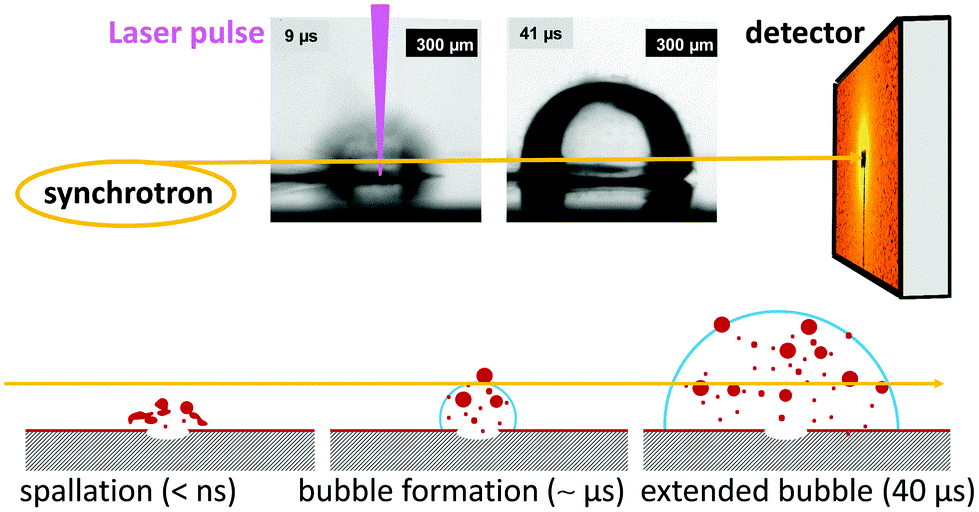Nanoparticle synthesis in a bubble
The processes involved in pulsed laser ablation in liquid (PLAL) are manifold and span time scales from the picosecond laser-matter interaction to nanosecond structure formation (nanometer) up to millisecond macroscopic dynamics (millimeter scale) of the cavitation bubble. Therefore, it is difficult to disentangle all the mechanisms that lead to a definition of particle sizes and define a feedback for tailoring particle yield, morphology and size definition. We have combined different approaches to investigate the process by X-ray and optical methods.

Figure 1: Analysis of the bubble formation (top row with optical stroboscopy images) and the material debris ejection (sketch in bottom row with SAXS) with the initial lift-off of a molten film and phase explosion products followed by break up into droplets and condensation into nanoparticles [2, CC-NC 3.0].

Figure 2: Overlay of edge-enhanced optical stroboscopic image of the cavitation bubble on a wire target with signal from dark-field imaging indicating microscale inhomogeneities, such as nanoparticles and permanent-gas microbubbles, see [4].
In particular, small-angle X-ray scattering (SAXS) and X-ray imaging are combined to a multiplexed SAXS method to achieve a nanoscale resolution in millimeter-scale imaging [1]. This contrast variation (absorption, differential phase and dark-field) is achieved by a hard-X-ray shack-Hartmann setup with microsecond time resolution (link: https://www.ips.kit.edu/2786_6162.php.)
Latest results include
· the proof of nanoparticle genesis by a lift-off of molten material and droplet formation by Rayleigh-Taylor instability [2]
· the role of plasma ignition and incubation for the localization of laser pulse energy at the ablated surface [3]
· the action of size-quenching additives during the early process of cavitation and particle formation of noble metal nanoparticles [4].
A summary of typical processes in energetic cavitation is given in a recent review [5].
Publications:
[1] T. dos Santos Rolo, S. Reich, D. Karpov, S. Gasilov, T. Baumbach, D. Kunka, A. Plech: A Shack-Hartmann sensor for single-shot multi-contrast direct- and reciprocal space in-situ imaging with hard X-rays, Appl. Sci. (Basel) 8 (2018) 737.
[link: http://www.mdpi.com/2076-3417/8/5/737 ]
[2] S. Reich, A. Letzel, A. Menzel, N. Kretzschmar, B. Gökce, S. Barcikowski, A. Plech: Early appearance of crystalline nanoparticles in pulsed laser ablation in liquids dynamics, Nanoscale 11 (2019) 6962 - 6969.
[link: https://pubs.rsc.org/en/content/articlehtml/2019/nr/c9nr01203f ]
[3] S. Reich, A. Letzel, B. Gökce, A. Menzel, S. Barcikowski, A. Plech: Incubation effect of pre-irradiation on bubble formation and ablation in laser ablation in liquids, ChemPhysChem 20 (2019) 1036-1043.
[link: https://onlinelibrary.wiley.com/doi/full/10.1002/cphc.201900075 ]
[4] A. Letzel, S. Reich, T. dos Santos Rolo, A. Kanitz, J. Hoppius, A. Rack, M. Olbinado, A. Ostendorf, B. Gökce, A. Plech, S. Barcikowski: Time and Mechanism of Nanoparticle Functionalization by Macromolecular Ligands during Pulsed Laser Ablation in Liquids, Langmuir 35 (2019) 3038-3047.
[link: https://pubs.acs.org/doi/10.1021/acs.langmuir.8b01585 ]
[5] S. Barcikowski, A. Plech, K. S. Suslick, A. Vogel: Materials synthesis in a bubble, MRS Bulletin 44 (2019) 382-391.
